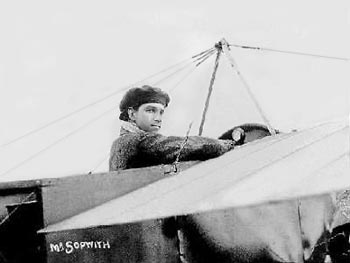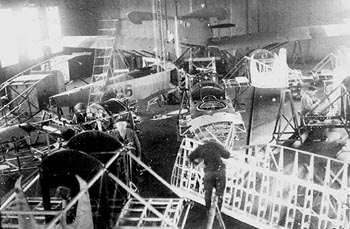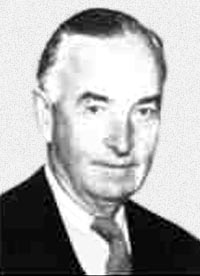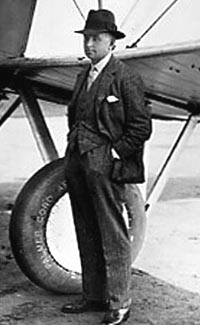
Sir Thomas Octave Murdoch 'T.O.M' Sopwith (1888 - 1989)
XIII. First Fliers in England Another notable figure of the early period was 'Tommy' Sopwith, who took his flying brevet at Brooklands in November of 1910, and within four days made the British duration record of 108 miles in 3 hours 12 minutes. On December 18th, 1910, he won the Baron de Forrest prize of L4,000 for the longest flight from England to the Continent, flying from Eastchurch to Tirlemont, Belgium, in three hours, a distance of 161 miles.
Aeroplanes and Airmen : A Famous British Inventor of the Water-Plane Though Harry Hawker made such a brilliant and gallant attempt to win the L5000 prize, we must not forget that great credit is due to Mr. Sopwith, who designed the water-plane, and to Mr. Green, the inventor of the engine which made such a flight possible, and enabled the pilot to achieve a feat never before approached in any part of the world. The life-story of Mr. "Tommy" Sopwith is almost a romance. As a lad he was intensely interested in mechanics, and we can imagine him constructing all manner of models, and enquiring the why and the wherefore of every mechanical toy with which he came into contact. At the early age of twenty-one he commenced a motor business, but about this time engineers and mechanics all over the country were becoming greatly interested in the practical possibilities of aviation. Mr. Sopwith decided to learn to fly, and in 1910, after continued practice in a Howard Wright biplane, he had become a proficient pilot. So rapid was his progress that by the end of the year he had won the magnificent prize of L4000 generously offered by Baron de Forest for the longest flight made by an all-British machine from England to the Continent. In this flight he covered 177 miles, from Eastchurch, Isle of Sheppey, to the Belgian frontier, in three and a half hours. If Mr. Sopwith had been in any doubt as to the wisdom of changing his business this remarkable achievement alone must have assured him that his future career lay in aviation. In 1911 he was graciously received by King George V at Windsor Castle, after having flown from Brooklands and alighted on the East Terrace of the famous castle. In the same year he visited America, and astonished even that go-ahead country with some skilful flying feats. To show the practical possibilities of the aeroplane he overtook the liner Olympic, after she had left New York harbour on her homeward voyage, and dropped aboard a parcel addressed to a passenger. On his return to England he competed in the first Aerial Derby, the course being a circuit of London, representing a distance of 81 miles. In this race he made a magnificent flight in a 70-horse-power Bleriot monoplane, and came in some fifteen minutes before Mr. Hamel, the second pilot home. So popular was his victory that Mr. Grahame-White and several other officials of the London Aerodrome carried him shoulder high from his machine. From this time we hear little of Mr. Sopwith as a pilot, for, like other famous airmen, such as Louis Bleriot, Henri Farman, and Claude Grahame-White, who jumped into fame by success in competition flying, he has retired with his laurels, and now devotes his efforts to the construction of machines. He bids fair to be equally successful as a constructor of air-craft as he formerly was as a pilot of flying machines. The Sopwith machines are noted for their careful design and excellent workmanship. They are made by the Sopwith Aviation Company, Ltd., whose works are at Kingston-on-Thames. Several water-planes have been built there for the Admiralty, and land machines for the War Office. Late in 1913 Mr. Hawker left Britain for Australia to give demonstrations in the Sopwith machine to the Government of his native country. A fine list of records has for long stood to the credit of the Sopwith biplane. Among these are:
British Height Record (Pilot only) .......................11,450 feetMany of the Sopwith machines used in the European War were built specially to withstand rough climate and heavy winds, and thus they were able to work in almost every kind of weather. It was this fact, coupled with the indomitable spirit of adventure inherent in men of British race, that made British airmen more than hold their own with both friend and foe in the war.
Sir Thomas Sopwith His mechanical aptitude and abundant enthusiasm led Sir Thomas Octave Murdoch Sopwith (b. London, England January 18,1888, d. 6 February 1989 King's Somborne, England) into the infant aviation scene in 1910. At the venerable age of 92, he was still consulting in the affairs of his company, truly the elder statesman in the world of aviation. In the years prior to the World War I, he became England's premier aviator and established the first authoritative test pilot school in the world. He founded England's first major flight school, where those who were to lead British aviation in the coming decades received their flying training....more
The Mastery of The Air
Aeroplanes and Airmen : Sea-Planes for Warfare
"Even in the region of the air, into which with characteristic British prudence we have moved with some tardiness, the Navy need not fear comparison with the Navy of any other country. The British sea-plane, although still in an empirical stage, like everything else in this sphere of warlike operations, has reached a point of progress in advance of anything attained elsewhere.So said Mr. Winston Churchill at the Lord Mayor's Banquet held in London in 1913, and I have quoted his speech because such a statement, made at such a time, clearly shows the attitude of the British Government toward this new arm of Imperial Defence. In bygone days the ocean was the great highway which united the various quarters of the Empire, and, what was even more important from the standpoint of our country's defence, it was a formidable barrier between Britain and her Continental neighbours, "Which serves it in the office of a wall Or as a moat defensive to a house." But the ocean is no longer the only highway, for the age of aerial navigation has arrived, and, as one writer says:
"Every argument which impelled us of old to fight for the dominion of the sea has apparently been found valid in relation to the supremacy of the air."From some points of view this race between nations for naval and aerial supremacy may be unfortunate, but so long as the fighting instinct of man continues in the human race, so long as rivalry exists between nations, so long must we continue to strengthen our aerial position. Britain is slow to start on any great venture where great change is effected. Our practice is rather to wait and see what other nations are doing; and there is something to be said for this method of procedure. In the art of aviation, and in the construction of air-craft, our French, German, and American rivals were very efficient pacemakers in the aerial race for supremacy, and during the years 1909-12 we were in grave peril of being left hopelessly behind. But in 1913 we realized the vital importance to the State of capturing the first place in aviation, particularly that of aerial supremacy at sea, for the Navy is our first line of defence. So rapid has been our progress that we are quite the equal of our French and German rivals in the production of aeroplanes, and in sea-planes we are far ahead of them, both in design and construction, and the war has proved that we are ahead in the art of flight. The Naval Air Service before the war had been establishing a chain of air stations round the coast. These stations are at Calshot, on Southampton Water, the Isle of Grain, off Sheerness, Leven, on the Firth of Forth, Cromarty, Yarmouth, Blythe, and Cleethorpes. But what is even more important is the fact that the Government is encouraging sea-plane constructors to go ahead as fast as they can in the production of efficient machines. Messrs. Short Brothers, the Sopwith Aviation Company, and Messrs. Roe are building high-class machines for sea work which can beat anything turned out abroad. Our newest naval water-planes are fitted with British-built wireless apparatus of great range of action, and Messrs. Short Brothers are at the present time constructing for the Admiralty, at their works in the Isle of Sheppey, a fleet of fighting water-planes capable of engaging and destroying the biggest dirigible air-ships. In 1913 aeroplanes took a very prominent part in our naval manoeuvres, and the cry of the battleship captains was:
"Give us water-planes. Give us them of great size and power, large enough to carry a gun and gun crew, and capable of taking twelve-hour cruises at a speed much greater than that of the fastest dirigible air-ship, and we shall be on the highroad to aerial supremacy at sea."The Admiralty, acting on this advice, at once began to co-operate with the leading firms of aeroplane constructors, and at a great rate machines of all sizes and designs have been turned out. There were light single-seater water-planes able to maintain a speed of over a mile a minute; there were also larger machines for long-distance flying which could carry two passengers. The machines were so designed that their wings could be folded back along their bodies, and their wires, struts, and so on packed into the main parts of the craft, so that they were almost as compact as the body of a bird at rest on its perch, and they took up comparatively little space on board ship. A brilliantly executed raid was carried out on Cuxhaven, an important German naval base, by seven British water-planes, on Christmas Day, 1914. The water-planes were escorted across the North Sea by a light cruiser and destroyer force, together with submarines. They left the war-ships in the vicinity of Heligoland and flew over Cuxhaven, discharging bombs on points of military significance, and apparently doing considerable damage to the docks and shipping. The British ships remained off the coast for three hours in order to pick up the returning airmen, and during this time they were attacked by dirigibles and submarines, without, however, suffering damage. Six of the sea-planes returned safely to the ships, but one was wrecked in Heligoland Bight. But the present efficient sea-plane is a development of the war. In the early days many of the raids of the "naval wing" were carried out in land-going aeroplanes. Now the R.N.A.S., which came into being as a separate service in July, 1914, possess two main types of flying machine, the flying boat and the twin float, both types being able to rise from and alight upon the sea, just as an aeroplane can leave and return to the land. Many brilliant raids stand to the credit of the R.N.A.S. The docks at Antwerp, submarine bases at Ostend, and all Germany's fortified posts on the Belgian coast, have seldom been free from their attentions. And when, under the stress of public outcry, the Government at last gave its consent to a measure of "reprisals" it was the R.N.A.S. which opened the campaign with a raid upon the German town of Mannheim. As the war continued the duties of the naval pilot increased. He played a great part in the ceaseless hunt for submarines. You must often have noticed how easily fish can be seen from a bridge which are quite invisible from the banks of the river. On this principle the submarine can be "spotted" by air-craft, and not until the long silence upon naval affairs is broken, at the end of the war, shall we know to what extent we are indebted to naval airmen for that long list of submarines which, in the words of the German reports, "failed to return" to their bases. In addition to the "Blimps" of which mention has been made, the Royal Naval Air Service are in charge of air-ships known as the Coast Patrol type, which work farther out to sea, locating minefields and acting as scouts for the great fleet of patrol vessels. The Service has gathered laurels in all parts of the globe, its achievements ranging from an aerial food service into beleaguered Kut to the discovery of the German cruiser Konigsberg, cunningly camouflaged up an African creek.
Sir Thomas Sopwith Thomas Octave Murdoch Sopwith est un inventeur anglais de génie, qui bâtit une véritable fortune durant sa vie. Créateur du "Sopwith Camel", le premier avion de chasse de la guerre 14-18, premier à dépasser 50 noeuds sur l'eau à bord d'un bateau à moteur, il conçut aussi le "Hurricane", un des chasseurs de la Bataille d'Angleterre, et le "Harrier", premier avion de chasse à décoller à la verticale. Fondateur de l'industrie aéronautique moderne en Grande-Bretagne, Sir Sopwith s'efforça de remettre au gôut du jour le vieil adage "Britannia rules the waves". En 1934, il affronte Harold Vanderbilt , et son Endeavour a course gagnée quand Sherman Hoyt déclenche un miracle et parvient à bloquer l'Anglais. Sur son lit de mort, Sir Sopwith, à 101 ans, répètait encore que le comité de course avait toujours refusé d'écouter sa réclamation.
Sopwith helped to father the Jet Age One of the many Early Birds to win international fame is Sir Thomas Sopwith, and the Spring, 1956 issue of the Jet Age put out by A. V. Roe Canada Limited for its member companies carries an excellent story on his many contributions to aviation and the new jet age. Pioneer air pilot, racing car driver, motorboat champion, Sir Thomas Sopwith has been famous in all three roles. But perhaps his greatest contribution to progress has been made through aircraft designing and manufacturing, a particularly as head of the Hawker Siddeley Group.
 'Tommy' Sopwith at Brooklands, c.1913
In 1906, at 18, while auto-racing at Brookland --- which at that time was also being used as an airfield --- he became greatly interested in flying, and soon bought his first aeroplane --- a 40 h.p. Howard Wright monoplane. On October 22, 1910, he made his first flight . . . and crashed. Within a month, with a new biplane, he obtained his pilot's certificate, No. 31, and the same day took up his first passenger. Soon afterwards he commenced building biplanes and obtained an order from the War Office for 12 aircraft. His company won the Schneider Trophy at Monte Carlo in 1914. During the First World War, Sir Thomas produced many successful aircraft. The "Pup", "Triplane", "Camel", "Snipe", "Dolphin", and "Salamander" were the greatest contributions to eventual British air supremacy....more
Engines of Our Ingenuity : Thomas Sopwith The airplane that finally brought down the Red Baron, Manfred von Richtofen, was an English biplane called the Sopwith Camel. ...Sopwith referred to its maker, Thomas Octave Murdoch Sopwith. The WW-I air war was, in large measure a duel between Sopwith and the maker of German airplanes, Fokker. Sopwith learned to fly in 1910, when he was twenty-two. By then, he'd raced automobiles and speedboats, and he'd done daredevil ballooning. In no time, he won flying prizes and used the prize money to start making airplanes. Like Fokker, he was a young airplane maker, ready for World War I....more
Sopwith Aviation Company at Kingston-on-Thames Thomas Octave Murdoch Sopwith was born in 1888. A well known pioneer aviator, he later established himself as a designer and builder of aircraft in 1913 at his shed at Brooklands in England.
 Sopwith factory c.1913 download a 500pixel or 750pixel image
In 1913 Sopwith produced the Tabloid, a fast and clean scout that was initially in 1914 used for it's scouting role. With war escalating and the needs of the aviation arms of Britain and France changing rapidly, the Sopwith factory produced a series of designs from the Baby to the Pup to the agile Triplane. In 1916 the Company produced the Camel, a powerful and manouvreable aircraft with twin Vickers machine guns. The development of the Camel, the Snipe represented the maximum efficiency that could be gained from the small rotary engined scout. There were also numerous other Sopwith designs, from small nimble scouts, to amphibians to strategic bombers and transport aircraft. The chief test pilot of Sopwith's was Harry Hawker, a pionering Australian who before his death in 1921 and with the insolvency of the Sopwith company post-war started the Hawker Engineering Company. Which 20 years later was to produce the Hawker Hurricane.
|
© Copyright 1999-2002 CTIE - All Rights Reserved - Caution |
 A History of Aeronautics
A History of Aeronautics